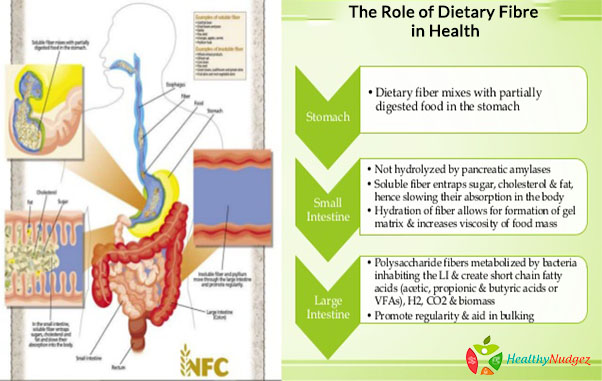The Role of Dietary Fibre in Health
Dietary fibre is primarily that part of plants in diet, which is resistant to digestion by the gut enzymes and are not absorbed into the system. Examples of fibre are cellulose, hemi-cellulose, lignin,, pectin, gum, mucilage, etc. There are basically two types of fibre which are available through our diet- soluble and insoluble. But most appropriately fibres that are soluble are also fermentable; e.g. cellulose, hemicellulose, lignin and those that are insoluble are less or non- fermentable; e.g. pectin, gums and mucilage.
Dietary fibre does not provide any nutrition as such to the human body. Then how and why are fibres important to us?
There are many roles of dietary fibre both, soluble and insoluble fibre. These have been proved through various studies and are listed below:
- Dietary fibre promotes satiety for a prolonged period of time, therefore helps in regulating overall intake of calories and reduces risk od development of obesity. Many epidemiologic and cross-sectional studies, have indicated that diets low in dietary fibre are associated with increased risk for obesity (Alfieri et al. 1995, Burkitt and Trowell 1975, Van Itallie 1978).
- Dietary fibre reduces the total cholesterol levels in blood. Soluble fibre from oats, guar gum, psyllium, apple, etc, have shown to reduce total and LDL (low density Lipoproteins) Cholesterol. The undigested fibre reaches the large intestine where it binds with bile and cholesterol, which are normally sent beck to the circulation, thereby reducing blood cholesterol levels. (Anderson et al. 1973).
- Dietary fibre has an effect on the blood sugar levels. As fibre has more viscosity, which causes slower absorption of nutrients into the blood stream, this effects the insulin sensitivity and thus controlled sugar levels (Miranda and Horwitz 1978; Simpson et al. 1981; Walker 1975)
- Dietary fibre improves gut motility or gastrointestinal function. Dietary fibre promotes laxation by increasing the bulk of undigested material in the large intestine. This helps to control both diarrhoea, where it helps in binding the waste material and constipation by increasing the bulk of waste (Takahashi et al. 1994). This mechanism also is helpful in improving conditions like IBD (intestinal bowel disease) and Piles.
- Presence of sufficient amount of fibre in diet has also shown to reduce risk of the cancers of the GI tract especially colon cancer. Through its effect f increasing the bulk of the waste in the colon, fibre helps in lowering the concentration of fecal carcinogens and so lowering the content of carcinogens that come in contact with the gut wall. (Hill 1974; Burkitt 1975).
- Also, there have been studies that shown reduced risk of coronary artery disease and thrombosis (atherosclerosis) related deaths. (Heller et al. 1980). So dietary fiber reduces the risk of heart disease.
Some good sources of fibre are:
- Oats
- Whole cereals and grains
- Ragi
- Corn
- Psyllium husk
- Fennel seeds
- Sprouted legumes
- Legumes and pulses
- Soybean
- Beans
- Peas
- Flaxseeds
- Sesame seeds
- Nuts especially Almonds (with skin)
- Most vegetables and
- Fruits (especially those that are eaten whole
Foods that are low in fibre are: Meats, fish, eggs, fruit and vegetable juices (fresh or packaged), peeled fruits, cookies, cakes, cheese, butter, refined cereals, white rice, milk and products, fruit flavoured drinks, fizzy drinks, canned and cooked fruits.
The daily recommendations are about 35-40gm of fibre per day for adult males and 20-26gm of fibre per day for adult females.
Ways of introducing more fibre in your daily diet:
- Use more of whole grains in place of refined cereals.
- Increase use of fruits and vegetables and reduce juices and canned fruits and vegetables.
- Include high fibre snacks in daily diet like sprouts and nuts.
- Include Flaxseeds and psyllium in daily diet if your diet is otherwise deficient in dietary fibre.
- Try to incorporate a whole grain breakfast cereal daily.
- Soups should contain pieces of vegetables which can give some fibre and not strained or pulverised.
- A minimum of 25-30% plate in each meal should consist of fibre rich foods
In conclusion we can say that diets with high fibre content have positive health benefits and help to reduce obesity, cardiovascular disease, type 2 diabetes, and some cancers. Also improved laxation and reduced diseases of the gastro Intestinal Tract (GI Tract)


Very informative